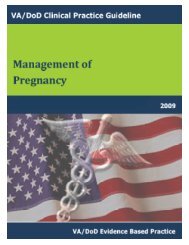DM Full Guideline (2010) - VA/DoD Clinical Practice Guidelines Home
DM Full Guideline (2010) - VA/DoD Clinical Practice Guidelines Home
DM Full Guideline (2010) - VA/DoD Clinical Practice Guidelines Home
You also want an ePaper? Increase the reach of your titles
YUMPU automatically turns print PDFs into web optimized ePapers that Google loves.
Version 4.0<br />
EVIDENCE TABLE<br />
<strong>VA</strong>/<strong>DoD</strong> <strong>Clinical</strong> <strong>Practice</strong> <strong>Guideline</strong><br />
for the Management of Diabetes Mellitus<br />
Recommendation Sources LE QE SR<br />
1 Choice of drug must be based on a variety of clinical factors Work Group consensus III Poor I<br />
and individual patient characteristics, including<br />
predisposition to adverse effects, the degree of<br />
hyperglycemia<br />
2 Metformin (preferred) or sulfonylurea as first line for most<br />
patients<br />
Bolen et al., 2007 I Good A<br />
3 TZDs, alpha-glucosidase inhibitors, meglitinides, DPP-4 Work Group Consensus II-1 Fair B<br />
inhibitors, and GLP-1 agonists as alternative agents for<br />
patients unable to use metformin or sulfonylureas due to<br />
contraindications, adverse effects, or other reasons<br />
4 Insulin should be considered in any patient with extreme Work Group Consensus II-1 Fair B<br />
hyperglycemia or significant symptoms; even if transition<br />
to therapy with oral agents is intended as hyperglycemia<br />
improves<br />
5 Patients and their families should be instructed to recognize Work Group Consensus III Poor I<br />
signs and symptoms of hypoglycemia and its management<br />
LE-Level of Evidence; QE = Quality of Evidence; SR = Strength of Recommendation (see Appendix A)<br />
J-2. COMBINATION THERAPY (Add-on)<br />
BACKGROUND<br />
When initial therapy no longer provides adequate glycemic control, addition of a drug from another class rather than<br />
substitution (reserve substitution for intolerance/adverse effect to a drug) is usually necessary. Combination of two<br />
anti-hyperglycemic drugs has the benefit of reducing hyperglycemia by working on different mechanisms that cause<br />
hyperglycemia (refer to Figure G-2). Although the evidence is clear on the relative efficacy of the various<br />
medications, their usage needs to be guided by clinical practice. In reality, not all combinations of drugs used in<br />
practice have evidence. Additionally, the data are limited on comparison of different combination regimens that<br />
assess which combination is preferred.<br />
Several factors should be considered when selecting combination therapy. These factors include, but are not limited<br />
to the following: how much the HbA 1 c needs to be reduced, tolerability of an agent, relative or absolute<br />
contraindications a patient may have to using a particular agent, barriers to proper administration. Because of all<br />
these factors, several options for combination therapy should be available.<br />
RECOMMENDATIONS<br />
1. Metformin + sulfonylurea is the preferred oral combination for patients who no longer have adequate<br />
glycemic control on monotherapy with either drug. [A]<br />
2. Other combinations (TZDs, AGIs, meglitinides, DPP-4 inhibitors, and GLP-1 agonists) can be considered<br />
for patients unable to use metformin or a sulfonylurea due to contraindications, adverse events, or risk for<br />
adverse events (see Appendices G-2 and G-3). [B]<br />
3. Addition of bedtime NPH or daily long-acting insulin analog to metformin or sulfonylurea should be<br />
considered, particularly if the desired decrease in HbA 1 c is not likely to be achieved by use of combination<br />
oral therapy. [A]<br />
4. Patients and their families should be instructed to recognize signs and symptoms of hypoglycemia and its<br />
management. [I]<br />
DISCUSSION<br />
The systematic review by the Agency for Healthcare Research and Quality found that combination therapy with<br />
TZDs, SU, metformin and repaglinide were additive and provided an additional 1% decrease in HbA 1 c over<br />
Module G: Glycemic Control Page 57
















